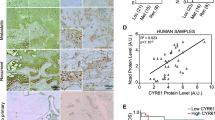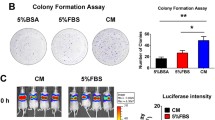Abstract
The outcomes of osteosarcoma patients still remain poor because of intractable pulmonary metastasis. We previously established a highly metastatic osteosarcoma cell line, LM8 from Dunn mouse osteosarcoma by in vivo selection. We herein aimed to clarify the characteristic biological features related with high metastatic potential and new target molecules to suppress pulmonary metastasis of osteosarcoma, using this syngeneic spontaneous metastatic model. LM8 cells acquired fibroblastic morphology with striking filopodia on the cell surface. Immunostaining showed faint stress fiber formation and peripherally localized integrin β1, and biochemical analyses showed the activated Cdc42 and autophosphorylation of focal adhesion kinase (FAK) in LM8 cells when compared to Dunn cells. LM8 cells had activated motility in single cell migration mode. LM8 migration was increased by a Rho-associated kinase (ROCK) inhibitor, Y-27632, while decreased by Cdc42 silencing using RNA interference system. We found that a clinically approved camptothecin analog, irinotecan suppressed the migration, Cdc42 activity, and autophosphorylation of FAK, and attenuated integrin β1 distribution selectively in LM8 cells. Daily oral administration of irinotecan significantly reduced the rate and size of pulmonary metastasis in syngeneic C3H mice. The fibroblastic morphology and activated cell migration with the dependency on Cdc42 but not Rho-ROCK signaling pathway argued that LM8 moved in mesenchymal mode of cell migration. This activated mesenchymal migration was a key component of the pulmonary metastasis of LM8 cells. The inhibition of mesenchymal migration by irinotecan, in addition to its cytotoxic effects, might be effective in preventing pulmonary metastasis of osteosarcoma.





Similar content being viewed by others
Abbreviations
- ECM:
-
Extracellular matrix
- 3D:
-
Three dimensions
- FAK:
-
Focal adhesion kinase
- MMP:
-
Matrix metalloproteinase
- ROCK:
-
Rho-associated kinase
References
Lewis IJ, Nooij MA, Whelan J et al (2007) Improvement in histologic response but not survival in osteosarcoma patients treated with intensified chemotherapy: a randomized phase III trial of the European Osteosarcoma Intergroup. J Natl Cancer Inst 99(2):112–128
Meyers PA, Schwartz CL, Krailo M et al (2005) Osteosarcoma: a randomized, prospective trial of the addition of ifosfamide and/or muramyl tripeptide to cisplatin, doxorubicin, and high-dose methotrexate. J Clin Oncol 23(9):2004–2011
Goorin AM, Schwartzentruber DJ, Devidas M et al (2003) Presurgical chemotherapy compared with immediate surgery and adjuvant chemotherapy for nonmetastatic osteosarcoma: Pediatric Oncology Group Study POG-8651. J Clin Oncol 21(8):1574–1580
Kager L, Zoubek A, Potschger U et al (2003) Primary metastatic osteosarcoma: presentation and outcome of patients treated on neoadjuvant Cooperative Osteosarcoma Study Group protocols. J Clin Oncol 21(10):2011–2018
Dunn TB, Andervont HB (1963) Histology of some neoplasms and non-neoplastic lesions found in wild mice maintained under laboratory conditions. J Natl Cancer Inst 31:873–901
Asai T, Ueda T, Itoh K et al (1998) Establishment and characterization of a murine osteosarcoma cell line (LM8) with high metastatic potential to the lung. Int J Cancer 76(3):418–422
Sahai E (2007) Illuminating the metastatic process. Nat Rev Cancer 7(10):737–749
Gupta GP, Massague J (2006) Cancer metastasis: building a framework. Cell 127(4):679–695
Pantel K, Brakenhoff RH (2004) Dissecting the metastatic cascade. Nat Rev Cancer 4(6):448–456
Yamaguchi H, Wyckoff J, Condeelis J (2005) Cell migration in tumors. Curr Opin Cell Biol 17(5):559–564
Friedl P, Wolf K (2003) Tumour-cell invasion and migration: diversity and escape mechanisms. Nat Rev Cancer 3(5):362–374
Friedl P (2004) Prespecification and plasticity: shifting mechanisms of cell migration. Curr Opin Cell Biol 16(1):14–23
Thiery JP (2002) Epithelial-mesenchymal transitions in tumour progression. Nat Rev Cancer 2(6):442–454
Poste G, Fidler IJ (1980) The pathogenesis of cancer metastasis. Nature 283(5743):139–146
Ren XD, Kiosses WB, Schwartz MA (1999) Regulation of the small GTP-binding protein Rho by cell adhesion and the cytoskeleton. EMBO J 18(3):578–585
Mettouchi A, Klein S, Guo W et al (2001) Integrin-specific activation of Rac controls progression through the G(1) phase of the cell cycle. Mol Cell 8(1):115–127
Yoshioka K, Nakamori S, Itoh K (1999) Overexpression of small GTP-binding protein RhoA promotes invasion of tumor cells. Cancer Res 59(8):2004–2010
Sotobori T, Ueda T, Myoui A et al (2006) Bone morphogenetic protein-2 promotes the haptotactic migration of murine osteoblastic and osteosarcoma cells by enhancing incorporation of integrin beta1 into lipid rafts. Exp Cell Res 312(19):3927–3938
Nitta N, Tsuchiya T, Yamauchi A et al (2007) Quantitative analysis of eosinophil chemotaxis tracked using a novel optical device—TAXIScan. J Immunol Methods 320(1–2):155–163
Sano K, Yoshikawa M, Hayasaka S et al (2003) Simple non-ion-paired high-performance liquid chromatographic method for simultaneous quantitation of carboxylate and lactone forms of 14 new camptothecin derivatives. J Chromatogr B Analyt Technol Biomed Life Sci 795(1):25–34
Itoh K, Yoshioka K, Akedo H et al (1999) An essential part for Rho-associated kinase in the transcellular invasion of tumor cells. Nat Med 5(2):221–225
Furman WL, Crews KR, Billups C et al (2006) Cefixime allows greater dose escalation of oral irinotecan: a phase I study in pediatric patients with refractory solid tumors. J Clin Oncol 24(4):563–570
Kuppens IE, Dansin E, Boot H et al (2006) Dose-finding phase I clinical and pharmacokinetic study of orally administered irinotecan in patients with advanced solid tumors. Clin Cancer Res 12(12):3774–3781
Drengler RL, Kuhn JG, Schaaf LJ et al (1999) Phase I and pharmacokinetic trial of oral irinotecan administered daily for 5 days every 3 weeks in patients with solid tumors. J Clin Oncol 17(2):685–696
Wang W, Goswami S, Sahai E et al (2005) Tumor cells caught in the act of invading: their strategy for enhanced cell motility. Trends Cell Biol 15(3):138–145
Wyckoff JB, Pinner SE, Gschmeissner S et al (2006) ROCK- and myosin-dependent matrix deformation enables protease-independent tumor-cell invasion in vivo. Curr Biol 16(15):1515–1523
Philippar U, Roussos ET, Oser M et al (2008) A Mena invasion isoform potentiates EGF-induced carcinoma cell invasion and metastasis. Dev Cell 15(6):813–828
Ellenbroek SI, Collard JG (2007) Rho GTPases: functions and association with cancer. Clin Exp Metastasis 24(8):657–672
Condeelis J, Segall JE (2003) Intravital imaging of cell movement in tumours. Nat Rev Cancer 3(12):921–930
Giampieri S, Manning C, Hooper S et al (2009) Localized and reversible TGFbeta signalling switches breast cancer cells from cohesive to single cell motility. Nat Cell Biol 11(11):1287–1296
Vicente-Manzanares M, Cabrero JR, Rey M et al (2002) A role for the Rho-p160 Rho coiled-coil kinase axis in the chemokine stromal cell-derived factor-1alpha-induced lymphocyte actomyosin and microtubular organization and chemotaxis. J Immunol 168(1):400–410
Vega FM, Ridley AJ (2008) Rho GTPases in cancer cell biology. FEBS Lett 582(14):2093–2101
Nobes CD, Hall A (1999) Rho GTPases control polarity, protrusion, and adhesion during cell movement. J Cell Biol 144(6):1235–1244
Wilkinson S, Paterson HF, Marshall CJ (2005) Cdc42-MRCK and Rho-ROCK signalling cooperate in myosin phosphorylation and cell invasion. Nat Cell Biol 7(3):255–261
Yoshikawa H, Yoshioka K, Nakase T et al (2009) Stimulation of ectopic bone formation in response to BMP-2 by Rho kinase inhibitor: a pilot study. Clin Orthop Relat Res 467(12):3087–3095
Kashima T, Nakamura K, Kawaguchi J et al (2003) Overexpression of cadherins suppresses pulmonary metastasis of osteosarcoma in vivo. Int J Cancer 104(2):147–154
Pommier Y, Redon C, Rao VA et al (2003) Repair of and checkpoint response to topoisomerase I-mediated DNA damage. Mutat Res 532(1–2):173–203
Pommier Y, Cherfils J (2005) Interfacial inhibition of macromolecular interactions: nature’s paradigm for drug discovery. Trends Pharmacol Sci 26(3):138–145
Nitiss J, Wang JC (1988) DNA topoisomerase-targeting antitumor drugs can be studied in yeast. Proc Natl Acad Sci USA 85(20):7501–7505
Acknowledgments
We thank Dr. Takahashi (The 21st Century COE Formation, Kyoto University Graduate School of Medicine, Japan) for the expressing vectors of GST-Rhotekin and GST-PAK, and Dr. Yukawa (GE Healthcare Bioscience, Tokyo, Japan) for the analysis of EZ-TAXIScan data.
Author information
Authors and Affiliations
Corresponding author
Electronic supplementary material
Below is the link to the electronic supplementary material.
Supplementary material 7 (MP4 792 kb)
Supplementary material 8 (MP4 793 kb)
Supplementary material 9 (MP4 1292 kb)
Rights and permissions
About this article
Cite this article
Yui, Y., Itoh, K., Yoshioka, K. et al. Mesenchymal mode of migration participates in pulmonary metastasis of mouse osteosarcoma LM8. Clin Exp Metastasis 27, 619–630 (2010). https://doi.org/10.1007/s10585-010-9352-x
Received:
Accepted:
Published:
Issue Date:
DOI: https://doi.org/10.1007/s10585-010-9352-x




